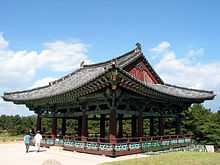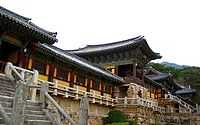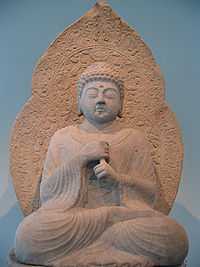Unified Silla
| Unified Silla | |
 Anapji pavilion | |
| Korean name | |
|---|---|
| Hangul | 통일 신라 |
| Hanja | 統一新羅 |
| Revised Romanization | Tong(-)il Silla |
| McCune–Reischauer | T'ongil Silla |
Part of a series on the |
||||||||
|---|---|---|---|---|---|---|---|---|
| History of Korea | ||||||||
 | ||||||||
| Prehistory | ||||||||
| Ancient | ||||||||
| Proto–Three Kingdoms | ||||||||
| Three Kingdoms | ||||||||
|
||||||||
| North and South States | ||||||||
|
||||||||
| Later Three Kingdoms | ||||||||
|
||||||||
| Unitary dynastic period | ||||||||
|
||||||||
| Colonial period | ||||||||
|
||||||||
| Division of Korea | ||||||||
|
||||||||
| By topic | ||||||||
| Timeline | ||||||||
| Korea portal | ||||||||
Unified Silla (668–935) or Later Silla is the name often applied to the Korean kingdom of Silla, one of the Three Kingdoms of Korea, when it conquered Baekje in 660 and Goguryeo in 668, unifying the southern portion of the Korean peninsula. Its last king, King Gyeongsun, ruled over a state in name only and submitted to the emerging Goryeo in 935, bringing the dynasty to an end.
Name
Modern Korean historians began to criticize the traditional view of Unified Silla as the unification of Korea. According to this perspective, Goryeo is considered the first unification of Korea, since Balhae still existed after the establishment of "Unified Silla", despite occupying territory north of the Korean peninsula.[1][2]
Unification
In 660, King Munmu of Silla ordered his armies to attack Baekje. General Kim Yu-shin, aided by Tang forces, defeated General Gyebaek and conquered Baekje. In 661, he moved on Goguryeo but was repelled. King Munmu was the first ruler ever to look upon the south of the Korean Peninsula as a single political entity after the fall of Gojoseon. As such, the post-668 Silla kingdom is often referred to as Unified Silla. Unified Silla lasted for 267 years until, under King Gyeongsun, it fell to Goryeo in 935.
Culture
Buddhism

Unified Silla and the Tang maintained close ties. This was evidenced by the continual importation of Chinese culture. Many Korean monks went to China to learn about Buddhism. The monk Hyech'o went to India to study Buddhism and wrote an account of his travels.[3] Different new sects of Buddhism were introduced by these traveling monks who had studied abroad such as Son and Pure Land Buddhism.[3]
Confucianism
A national Confucian college was established in 682 and around 750 it was renamed the National Confucian University.[3] The university was restricted to the elite aristocracy.
Woodblock printing
Woodblock printing was used to disseminate Buddhist sutras and Confucian works. During a refurbishment of the Pagoda That Casts No Shadows, an ancient print of a Buddhist sutra was discovered. The print is dated to 751 CE and is the oldest discovered printed material in the world.[3]
Economy
At first, Silla decreased agriculture output tax to one-tenth before unification and assigned tributary payment per town with special products.
Unified Silla conducted a census of all towns' size and population, as well as horses, cows and special products and recorded the data in Minjeongmunseo (민정문서). The reporting was done by the leader of each town.[4]
See also
- List of Korea-related topics
References
- ↑ Ch'oe, Yŏng-ho (1980), "An Outline History of Korean Historiography", Korean Studies 4: 23–25, doi:10.1353/ks.1980.0003
- ↑ Armstrong, Charles K. (1995), "Centering the Periphery: Manchurian Exile(s) and the North Korean State", Korean Studies (University of Hawaii Press) 19: 11–12, doi:10.1353/ks.1995.0017
- ↑ 3.0 3.1 3.2 3.3 Stearns, Peter N., ed. (2001). The Encyclopedia of World History: Ancient, Medieval, and Modern, Chronologically Arranged (6th ed.). New York: Houghton Mifflin Company. pp. 155–6. ISBN 0-395-65237-5. Retrieved August 22, 2010.
- ↑ Korean history for high school p.141, issued by The National History Compilation Committee of the Republic of Korea.